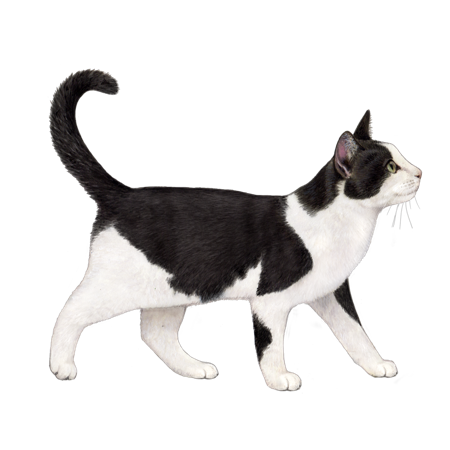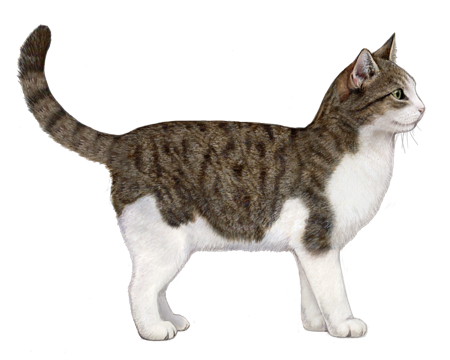
British Domestic Cat
British Domestic cats come in all shapes and sizes. There's no rule book for these kitties, but one thing is certain: there's bound to be a Domestic that's perfect for you.
Interested in discovering if your cat is a British Domestic Cat?
Check out Wisdom Panel's DNA test.
British Domestic Cat Traits
General Appearance
British Domestics come in a wide range of colors, sizes, and builds. Still, they're typically medium-sized and well-balanced.
Coat and Colouring
These cats can come in all coat colors, patterns, and lengths. If a coat combination is genetically possible, you're likely to see it in a British Domestic.
Distinctive Physical Traits
British Domestics don't have a defined breed standard. The typical Domestic may display any number of adorable features.
British Domestic Cat Temperament
Don't try to pin these cats down when it comes to personality. They can be quiet or vocal, cuddly or aloof. Getting to know a Domestic's unique personality is part of what makes them a fun household addition.
British Domestics are typically athletic cats with strong hunting instincts. Using feather wands and other toys they can pounce on or chase gives them a much-needed outlet for their natural tendencies.
Domestics also tend to enjoy keeping an eye on the outside world. High perches where they can safely look out at birds and other wildlife will keep them entertained for hours.
British Domestic Cat History
Despite the growing number of cat breeds in the world, the non-pedigreed Domestic cats hold the top spot when it comes to popularity. British Domestic cats, often called moggies, are random-bred cats that have been delighting pet owners in Britain for centuries.
Experts believe Roman armies brought the first cats to the island nearly 2,000 years ago. These cats became regular features on British streets. That is, until the Middle Ages when cats became associated with witchcraft. Suspicious locals rid their towns of cats, and the cat population significantly decreased.
British Domestic cats returned to good graces in the 1500s after the plague ravaged cities and towns. People then realized that cats' keen rat-hunting skills were a weapon against disease-spreading vermin. As a result, the popularity of these cats grew once again—this time for good.
Though British Domestics aren't purebred cats, some cat associations allow them to compete in shows in a general "housecat" category.
British Domestic Cat Care
Nutrition
British Domestic cats thrive on a high-quality diet. Because nutritional needs vary for kittens, adults, and senior cats, choose a formula that's age-appropriate for your pet.
To prevent overfeeding, carefully measure portions and reduce amounts if your cat gains excess weight. And keep an eye on how many treats you're giving them. As a guideline, treats should be kept to 10% of a cat's daily calories or less.
In addition to meals, provide your cat with plenty of fresh, clean water.
Grooming
These kitties are typically excellent self-groomers. Still, they need regular brushing to keep their coats looking their best. Weekly brushing is usually enough for shorthaired cats. Longhaired cats are more prone to tangles and mats and may require daily brushing.
In addition to combing, trim their claws monthly to prevent overgrowth. Overgrown nails are more likely to snag on something, become torn or damaged, or even grow into the paw pads—leading to pain or infection. In addition to clipping, a scratching post will help keep your cat's nails in good shape and satisfy their instinct to scratch.
Finally, all cats need regular dental care—including at-home teeth brushing and professional dental exams and cleanings.
Health
Obesity is a growing concern in cats. Extra weight can contribute to other health risks, such as arthritis, diabetes, and heart problems. Your veterinarian is a great resource for tips on keeping your cat at a healthy weight.
British Domestic Cat Genetic Health Conditions
-
Acute Intermittent Porphyria (Variant 1)
Acute Intermittent Porphyria (AIP) is caused by faulty enzyme activity and results in brownish discoloration of the teeth and urine in affected cats.
-
Acute Intermittent Porphyria (Variant 2)
Acute Intermittent Porphyria (AIP) is caused by faulty enzyme activity and results in brownish discoloration of the teeth and urine in affected cats.
-
Acute Intermittent Porphyria (Variant 5)
Acute Intermittent Porphyria (AIP) is caused by faulty enzyme activity and results in brownish discoloration of the teeth and urine in affected cats.
-
Congenital Adrenal Hyperplasia
Congenital Adrenal Hyperplasia is an endocrine disorder which leads to aggression, abnormalities of the genitalia, and excessive drinking and urination.
-
Congenital Erythropoietic Porphyria
Congenital Erythropoietic Porphyria (CEP) is caused by faulty enzyme activity and results in brownish discoloration of the teeth and urine in affected cats.
-
Cystinuria Type 1A
Cystinuria is a condition that predisposes cats to form cystine crystals and stones within the urinary tract, which can then cause irritation and blockage.
-
Cystinuria Type B (Variant 1)
Cystinuria is a condition that predisposes cats to form cystine crystals and stones within the urinary tract, which can then cause irritation and blockage.
-
Cystinuria Type B (Variant 2)
Cystinuria is a condition that predisposes cats to form cystine crystals and stones within the urinary tract, which can then cause irritation and blockage.
-
Cystinuria Type B (Variant 3)
Cystinuria is a condition that predisposes cats to form cystine crystals and stones within the urinary tract, which can then cause irritation and blockage.
-
Dihydropyrimidinase Deficiency
Dihydropyrimidinase Deficiency is a condition that causes tiredness, weakness, vomiting, and high levels of ammonia in the blood.
-
Earfold and Osteochondrodysplasia (Discovered in the Scottish Fold)
The Earfold and Osteochondrodysplasia variant results in the breed defining folded ears of Scottish Fold cats and is associated with skeletal malformations and arthritis.
-
Factor XII Deficiency (Variant 1)
Factor XII Deficiency, also known as Hageman trait, is an asymptomatic blood factor deficiency. While it does not cause an abnormal tendency to bleed, it can be observed as prolonged blood clotting times during certain laboratory screening tests.
-
Factor XII Deficiency (Variant 2)
Factor XII Deficiency, also known as Hageman trait, is an asymptomatic blood factor deficiency. While it does not cause an abnormal tendency to bleed, it can be observed as prolonged blood clotting times during certain laboratory screening tests.
-
Glutaric Aciduria Type II
Glutaric Aciduria Type II causes loss of appetite, vomiting and seizures in young cats.
-
GM1 Gangliosidosis
GM1 Gangliosidosis causes muscle tremors, uncoordinated movements, and blindness.
-
GM2 Gangliosidosis
GM2 Gangliosidosis causes muscle tremors, uncoordinated movements, difficulty eating, and blindness.
-
GM2 Gangliosidosis Type II (Discovered in Domestic Shorthair cats)
GM2 Gangliosidosis Type II causes muscle tremors, uncoordinated movements, difficulty eating, and blindness.
-
Hemophilia B (Variant 1)
Hemophilia B, or Factor IX Deficiency, is a blood clotting disorder that can result in tiredness, decreased appetite, fever, lameness, and prolonged bleeding times after injury, trauma or surgery.
-
Hemophilia B (Variant 2)
Hemophilia B, or Factor IX Deficiency, is a blood clotting disorder that can result in tiredness, decreased appetite, fever, lameness, and prolonged bleeding times after injury, trauma or surgery.
-
Hyperoxaluria Type II
Hyperoxaluria Type II is a kidney disorder leading to severe weakness and kidney failure in young cats.
-
Lipoprotein Lipase Deficiency
Lipoprotein Lipase Deficiency is a metabolic disorder that causes decreased body mass and reduced growth rates in affected kittens and can cause stillbirths in affected queens.
-
MDR1 Medication Sensitivity
MDR1 Medication Sensitivity is a disorder caused by a defect to a drug pumping protein that plays an important role in limiting drug absorption and distribution (particularly to the brain). Cats with the MDR1 variant may have severe adverse reactions to some commonly used medications.
-
Mucopolysaccharidosis Type I
Mucopolysaccharidosis Type I is a disorder causing failure to thrive, facial and other skeletal abnormalities, tremors, and clouding of the eyes.
-
Mucopolysaccharidosis Type VI
Mucopolysaccharidosis Type VI is a rare disorder causing dwarfism, degenerative joint disease, and clouding of the eyes.
-
Mucopolysaccharidosis Type VII (Variant 1)
Mucopolysaccharidosis Type VII is a disorder causing weakness, growth retardation, facial and other skeletal abnormalities, and clouding of the eyes.
-
Mucopolysaccharidosis Type VII (Variant 2)
Mucopolysaccharidosis Type VII is a disorder causing weakness, growth retardation, facial and other skeletal abnormalities, and clouding of the eyes.
-
Mucopolysaccharidosis Type VI Modifier
Mucopolysaccharidosis Type VI Modifier causes a mild degenerative joint disease, but only if one copy of Mucopolysaccharidosis Type VI is also present.
-
Myotonia Congenita
Myotonia Congenita is a condition that results in stiff movement and delayed relaxation of muscles after exercise.
-
Polycystic Kidney Disease (PKD)
Polycystic Kidney Disease (PKD) is the most common inherited disease in cats. The disease causes the formation of fluid-filled cysts in the kidneys that can lead to kidney failure.
-
Pyruvate Kinase Deficiency
Pyruvate Kinase (PK) Deficiency is a disorder that causes anemia due to the breakdown of red blood cells.
-
Sphingomyelinosis (Variant 1)
Sphingomyelinosis causes progressive incoordination and tremors, enlargement of the spleen and liver, and changes in the lungs.
-
Sphingomyelinosis (Variant 2)
Sphingomyelinosis causes progressive incoordination and tremors, enlargement of the spleen and liver, and changes in the lungs.
-
Vitamin D-Dependent Rickets
Vitamin D-Dependent Rickets results in skeletal abnormalities caused by low blood calcium levels.
With more than 45 health tests, Wisdom Panel™ Complete for Cats screens for these and other important genetic conditions—allowing you to better plan for your cat's lifelong care.
Breed Group
Western
The largest of breed groups, the Western Group is mainly comprised of cats developed in Europe and the Americas. Due to the complexity of feline genetic diversity, however, cat breeds from other regions may also be found associated with this group.
Resources
https://www.historic-uk.com/CultureUK/Cat-History-Of-Britain/
http://www1.fifeweb.org/dnld/std/HCL-HCS.pdf
Reviewed 21 June 2022 by Annette Louviere, DVM


























